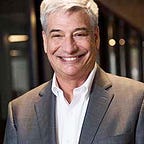What entrepreneurs can learn from the story of Trader Joe’s.
The founder of Trader Joe’s, Joe Coulombe, passed away last week. He started with a small set of convenience stores in LA that has grown to over 500 stores across the country with a very loyal following.
So what are the learnings that all of us as entrepreneurs can take from Joe Coulomb’s success story?
From corporate lackey to determined entrepreneur.
After graduating from Stanford in 1958, Coulombe went to work for Rexall, the largest retail pharmacy chain at the time. Rexall gave him the task of developing a new line of convenience stores in Southern California. He successfully got six “Pronto Markets” up and running before the Rexall corporate bigwigs back at headquarters changed their mind and told him to shut the stores down. He didn’t want to shut them down. So instead he borrowed money, bought them himself, and told his corporate bosses to shove it.
When competition arrives, be nimble and differentiate.
Coulombe grew his Pronto Markets to 18 locations around the LA area and was doing great until one day 7–Eleven, the convenience store giant in Dallas, announced they were entering the Los Angeles market. “They were so huge, I decided I’d better get the hell out of convenience-store retailing”, he recalled later. Rather than try to compete head-to-head with 7-Eleven, he changed-up his stores, came up with a new name, and gave them a South Seas motif with an eclectic set of products.
See trends that predict changes in customer taste.
Boeing was about to launch the 747, and suddenly international travel would be available to millions of Americans. Coulombe predicted this would increase consumers’ interest in exotic foods and what today we would call “ethnic cuisine”. So instead of carrying the same boring American food that most grocery stores carried he focused on a mix of interesting tastes from around the world. Nailing that trend would turn out to be key component to his success.
Identify and describe your target customer.
“What you want is a coherent group of customers,” he told Investor’s Business Daily in 1998, “and you shape yourself around it.” I think those words should be memorized by every entrepreneur — identify a coherent group of customers and then build your product offering around them. The 1960’s was a time in America when more people than ever were becoming college-educated, and Coulombe was in Southern California where many of them landed, trying to get jobs in the entertainment industry. He said he envisioned his new stores as being “for overeducated and underpaid people, for all the screenwriters, classical musicians, museum curators, and journalists”. Bingo — he identified and described a target market he could build a product offering around.
Localization matters.
Most chains have identical stores. The interior of a 7-Eleven in Chicago is identical to the interior of a 7-Eleven in Atlanta. Coulombe knew that he needed the scale economies of a chain, but wanted consumers to feel as if their neighborhood store was theirs, connected to their community. So Trader Joe’s hired in-house artists who match the decor of each store with the neighborhood it serves. They create signature wall murals (the Manhattan store has a rainbow Statue of Liberty, while the Santa Cruz store has surfers, for example) and the same in-house artists create all the signs and labels in each unique store. Customers like the benefits of a big chain but they also like a store that feels as if it has a connection to their community.
Listen to customers.
Over time, Coulombe added more organic and healthy items, because that’s what his “overeducated and underpaid” consumers were asking for. In 2007 they phased-out food imported from China because of customer concerns. They removed from their shelves six species of fish deemed by Greenpeace as “unsustainable”, and today only carry milk from cows not given artificial growth hormone. In recent years they’ve been criticized for their use of plastic packaging, which they are now phasing out. From the beginning, Coulombe had managers dressed in tropical shirts standing behind the front desk, asking customers what they liked, what they didn’t like, and what they wanted to see more of. And Coulombe listened.
Find that one key differentiator that attracts new customers.
No discussion of Trader Joe’s would be complete without talking about the wine section. At the time that Coulombe founded TJ’s, a typical grocery store might have 1% of their shelf space dedicated to wine; Trader Joe’s today has nearly 15% of their stores devoted to that one product category. Coulombe was a wine-lover himself, and he said later that he had read somewhere that “educated people tended to drink more wine” so that fit his vision of the customers he was targeting. In the 1960’s most consumers thought of fine wine as expensive and coming from France, but the California wine industry was just getting going so he decided he’d focus on “value wines”, largely from California. Eventually the famous “Two Buck Chuck” was born, a private label California wine exclusive to Trader Joe’s and selling for $1.99. Soon consumers were being introduced to Trader Joe’s via their wine selection — they would come in for the wine and discover they sold food, too!
Today, Trader Joe’s is owned by a guy in Germany, but it is still run with principles established by the founder, Joe Coulombe, many years ago.
The story of Trader Joe’s is a great parable of entrepreneurial success. Guy quits his corporate job, creates a new startup, dodges well-financed competition, listens to customers, creates millions of loyal followers, drinks a lot of good wine, and becomes a cultural icon.
Here’s to Joe Coulombe, and to “overeducated and underpaid people” everywhere.
This article was merged into my new book, The Launch Path, now available on Amazon.
